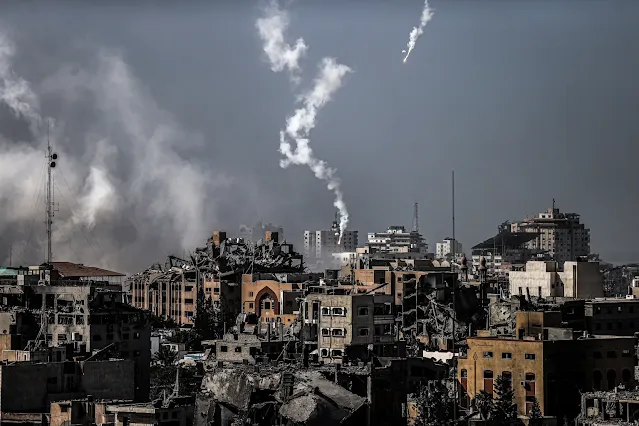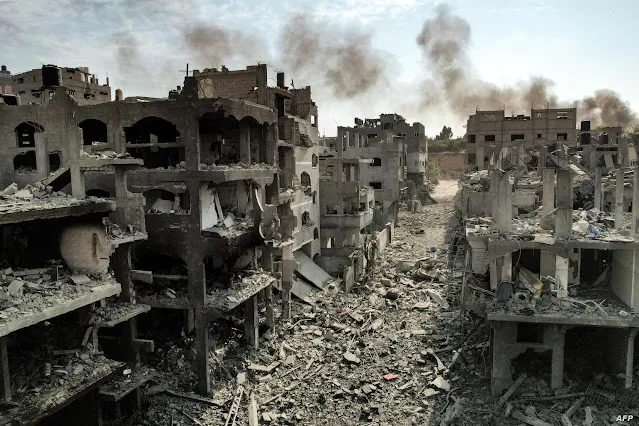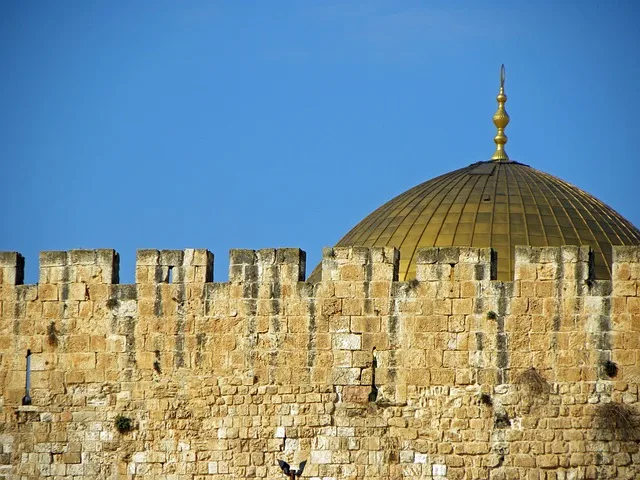By its location at the crossroads of civilizations, and being a prominent stop for pilgrims and an important trade route, Gaza has witnessed throughout its history many human cultures and civilizations, from the Canaanites to the Byzantine and Christian eras, and Islamic eras.
Historical periods influenced the development of Gaza, which left us with a rich cultural heritage. Although every stone in Gaza tells a unique story, its memory and heritage, which date back to different historical eras, were not spared the Israeli Holocaust.
As part of its ongoing retaliatory war on the besieged Gaza Strip since October 7, the Israeli occupation state is deliberately targeting historical monuments and ancient heritage neighborhoods that it continues to erase from the face of the earth.
In addition to burning educational and cultural institutions, places of worship, and libraries, especially symbols of living memory, and cleansing the remaining charitable institutions, this is certainly another horrific devastation of Gaza among the systematic destruction committed by the occupation.
It is known that past and current Israeli regimes have sought to eradicate the Palestinian heritage, by erasing records and documents, stealing archives, and destroying evidence of the historical connection of the Palestinians to their land to support their narrative and settlement project, so that only the Jewish presence remains.
But what is different about this war is that Israel is targeting everything that refers to Palestinian heritage and culture in Gaza quickly, and on a systematic and broader scale that exceeds previous wars, and without regard to the appearance of this undeniable destruction in full view of the world.
What is surprising is that this monster that is destroying the heritage and cultural features of Gaza is presented as civilized.
Gaza without Palestinians: the nightmare of resistance
The Zionists' targeting of educational and cultural institutions in Gaza as a military target in itself is not a random campaign, but rather a carefully designed policy to send a message beyond those who resist.
The occupation leaders realize that the “Al-Aqsa Flood” (2023 Hamas attack on Israel) has enhanced the prestige of the Al-Qassam Brigades fighters in the eyes of the Arab people in general and the Palestinian people in particular, as they have proven that they resist and sacrifice themselves for the cause.
Therefore, the occupation knows very well what this will entail, and it wants to extract this victory from souls at all costs, to give a harsh lesson to the new generations and to those who think about resistance.
From this standpoint, Gaza itself has become a symbolic target for practicing all forms of intimidation and extermination, not only by razing populated neighborhoods, depriving them of basic living needs, and creating a world in which the lives of Palestinians have no value.
Rather, the occupation wants to create living conditions aimed at leaving the worst memories, and for the people of Gaza to feel humiliated, even in a hospital, which it did not hesitate to besiege, bomb, and take the lives of thousands of children who died before they could pronounce their names, noting the emphasis that the greatness of Zionist power derives primarily from these practices.
The current Zionist project is not limited to turning the lives of the people of Gaza into terror until they surrender and abandon their homes.
It is also about uprooting them demographically and culturally and erasing their heritage to deprive them of any claim to their rights, and thus the Zionists view the sites that preserve the identity and history of the Palestinian people as a threat to them, and so they are burning them now.
The occupation has resorted to destroying heritage in Gaza to eliminate the cry of continuing resistance, and considering that these places that it is burning are not only considered a physical connection with the past, as much as they are a form of life, but they also wanted to prevent it from continuing and being created again to ensure the crushing of the memory of new generations...
Targeting memory is what is most painful and leaves pain in a person’s soul. When people are continuously displaced from their homes, they are accompanied by a feeling of oppression and sorrow because their history is being erased before them.
Also, when the occupation burns Gaza’s mosques that carry memories of history, people feel intense pain over the loss of this heritage, because it is an attack on their way of life, depriving them and their grandchildren of the right to belong to their identity.
Heritage in the Crossfire
According to the Palestinian Ministry of Culture, there are 76 cultural centers, 3 theaters, 5 museums, 15 book publishing houses, and 80 public libraries in Gaza, in addition to personal museums.
Most of these institutions operate with their efforts, not due to lack of official interest as much as the financial capabilities are limited, and the country is under siege and successive crises, so the people of Gaza have done their best to preserve their heritage, amid the conditions of the siege and the great challenges they face.
Below are the most prominent heritage sites in Gaza that were deliberately targeted by Zionist fire of hatred after the “Al-Aqsa Flood” battle:
According to the latest statements of the Palestinian Minister of Culture, Atef Abu Saif, the Zionists targeted most institutions in the cultural sector.
The Ministry of Culture documented the destruction of 6 cultural centers and 5 publishing houses that sold books: Al-Shorouk, Samir Mansour, Lobbad, Al-Naim, and Al-Nahda. Even the libraries that were not burned suffered severe damage to their infrastructure.
The museums and manuscripts sector was also subjected to a deliberate campaign of extermination, as the Zionists bombed the Khan Yunis Museum and destroyed a group of archaeological masterpieces in it.
The Arab Organization of Museums confirmed that two important museums in Gaza, the Al-Qarara Cultural Museum and the Rafah Museum, were destroyed.
In addition to the destruction of most parts of the Old City of Gaza, which contained 146 ancient houses, many mosques, markets, historical schools, and an old port listed on the preliminary list of World Heritage.
Not only that, mosques were also not spared brutality. So far, 47 mosques have been documented and turned to ashes by the occupation, including mosques that have a great influence on daily life and memory, including the Al-Susi and Al-Gharbi Mosques in Al-Shati refugee, and the Yarmouk and Al-Amin Mosques.
Several reports indicate the destruction of Jabalia Mosque, Ahmed Yassin Mosque in Al-Maghazi refugee, Abu Janab Mosque in eastern Khan Yunis, Khaled bin Al-Walid Mosque, and Al-Rida Mosque in Khan Yunis.
تغطية صحفية: الغارات الإسرائيلية تُدمر مسجد خالد بن الوليد غرب خانيونس. pic.twitter.com/7DELeAdCOO
— الجرمق الإخباري (@aljarmaqnet) November 8, 2023
According to preliminary documentation by the Palestinian Ministry of Religious Affairs, more than 50 mosques were razed to the ground, and there are mosques of archaeological and historical value that were destroyed to varying degrees.
This is in addition to the destruction of the headquarters of the Ministry of Religious Affairs and the 14-storey headquarters of the Holy Quran Radio, which is now buried under the rubble and destruction left by the occupation bombs.
 |
| A Palestinian raises the call to prayer on the ruins of Al-Amin Muhammad Mosque, which was bombed by the occupation forces in Khan Yunis, Gaza, on October 20, 2023. |
It must be noted that all of these mosques that were destroyed played an essential role in serving the needs of society for the residents of Gaza, as many of the targeted mosques provided them with social, educational, and health facilities.
Three churches were also bombed, including the Church of St. Porphyrius, which is popularly known in Gaza as the Greek Orthodox Church, and it is the oldest Christian church in Gaza.
In addition to the destruction of 80 government headquarters, and the bombing of the Palestinian Central Bureau of Statistics building, which was destroyed, means the loss of a documentary base for the government and society, thus depriving thousands of their documents and the disposal of their property.
 |
| Israeli occupation aircraft bombed Yarmouk Mosque on October 9, 2023 |
There is not a single institution that was not exposed to even partial damage. The occupation bombed many ministries, headquarters, and government institutions, and did not hesitate to target the health system and bomb the Al-Ahli Arab Hospital, which predates the history of the occupying state by many decades.
 |
| The annihilation of Yassin Mosque in Al-Shati refugee on October 9, 2023 |
This is in addition to dozens of cultural centers that have turned into dust and rubble, such as the Orthodox Cultural Center, which contained halls for organizing cultural and artistic activities.
In addition to the destruction of the Abnauna Association for Development, the Gaza Center for Culture and Arts, the destruction of Milad Association in the Jabalia refugee camp, the destruction of the Arab Social Cultural Center located in the Tel Al-Hawa neighborhood, and destruction of the Hakawi Theater Association.
The ancient houses were not spared from Israeli brutality. The occupation bombed the Al-Saqqa House, located in the Al-Shujaiya neighborhood, east of Gaza City, which was destroyed after it was restored in 2014.
It is considered one of the most beautiful and oldest houses, as its construction dates back 400 years. It was one of the few remaining cultural spaces for Palestinians in Gaza, as it was used as a cultural center.
The brutality also extended to universities, as Al-Azhar University was targeted, and the Islamic University was severely damaged.
The building of the College of Information Technology, the building of the Deanship of Community Service and Continuing Education, and the building of the College of Science, with all its equipment, laboratories, and furniture, were all exposed to incendiary shells.
The number of higher education students killed reached 438 male and female students, while 14 male and female workers who worked in higher education institutions were killed, and the number of higher education institutions that were partially or completely damaged reached 12 institutions.
مشاهد الدمار التي لحقت بمباني الجامعة الإسلامية بغزة نتيجة القصف الإسرائيلي العنيف على مربع الرمال. pic.twitter.com/aijgN7HShj
— وكالة شهاب للأنباء (@ShehabAgency) October 10, 2023
Also, school education institutions were not immune from the annihilation, as according to what the “Palestinian Central Bureau of Statistics” announced, 608 thousand students, both male and female, in Gaza were deprived of their right to school education.
So far, 239 schools have been bombed in Gaza, killing 3,141 students enrolled in the schools, 130 male and female teachers, and 103 UNRWA employees.
According to UNICEF data, more than 200 schools were damaged (about 40% of all schools in Gaza). In addition, Israel is currently using Gaza’s schools for military purposes.
Despite all this systematic destruction, even private and personal libraries did not escape the hell of the occupation. Within minutes, the occupation destroyed Hamza Mustafa’s library, and the fire consumed all the valuables in it after Hamza had been building it throughout his life.
The extermination machine also targeted intellectuals, artists, writers, and workers in the cultural field, as the Palestinian Ministry of Culture announced in a statement the killing of 15 intellectuals and artists, and there are stories about musicians who lost their ability to hear and painters who lost limbs from their bodies.
Israel justifies targeting heritage, religious, and educational sites by saying that resistance fighters store weapons and hide inside them, while there is no evidence to this moment for this claim, and Hamas has denied this accusation more than once.
Western hypocrisy in dealing with Palestinian heritage
Although cultural monuments enjoy special protection in international law, in the case of Gaza the matter seems different, as it is interesting the level of justifications given to “Israel” for the annihilation of Palestinian heritage in a way that exceeds all limits.
Especially since the Israeli forces, after targeting monuments of heritage, culture, and religion, announced that these raids were successful and directly hit their targets.
If we compare the reactions to the cultural destruction in Gaza with what happened in Ukraine, then what Russia did immediately required major reactions from the international community, and cultural institutions on the ground moved directly to protect Ukrainian heritage.
But these same institutions remain silent while Israel burns Gaza's heritage, and some of them launch accusations and lies and encourage genocide.
Like the Frankfurt Book Fair, which declared its bias towards the Zionist entity, and with the utmost arrogance decided to cancel the ceremony honoring the Palestinian writer Adania Shibli, the Frankfurt Fair’s position was not the only one.
 |
| One of Ayman Baalbaki's paintings was withdrawn on November 9, 2023, from Christie's Middle East Art auction. |
This is considered a scandal for the West, which calls for the preservation of heritage, but did not move to save the heritage and culture of Gaza as it did in many places, which indicates a policy of double standards, which uses agreements selectively and when they serve its own purposes.
Some countries and organizations still continue to justify cultural cleansing, arming the machine of extermination of the Palestinian people, and destroying the heritage and landmarks of Gaza.
Sadly, only a few of the affected cultural sites remain in Gaza. Most of them were partially destroyed or on the verge of collapse. The extent of the destruction is not yet clear.
The annihilation of heritage and memory in Gaza will remain a stark reminder of Western hypocrisy. In fact, the loss of cultural heritage landmarks in Gaza is not only a tragedy for the Palestinians but a loss for all of us.








.jpg)


















